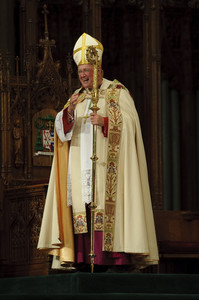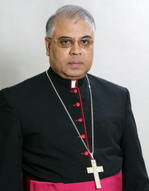Saint Gertrude the Great
A pivotal figure in our theology of the Sacred Heart of Jesus is Saint Gertrude the Great (1256-1302). She was a nun of the Abbey of Helfta. Saint Gertrude is the only woman on the liturgical calendar to hold the title “the Great.”
Gertrude was an extraordinary student, she learned everything that can be learned of the sciences of the trivium and quadrivium, the education of that time; she was fascinated by knowledge and threw herself into profane studies with zeal and tenacity, achieving scholastic successes beyond every expectation. If we know nothing of her origins, she herself tells us about her youthful passions: literature, music and song and the art of miniature painting captivated her. She had a strong, determined, ready and impulsive temperament. She often says that she was negligent; she recognizes her shortcomings and humbly asks forgiveness for them. She also humbly asks for advice and prayers for her conversion. Some features of her temperament and faults were to accompany her to the end of her life, so as to amaze certain people who wondered why the Lord had favoured her with such a special love.
Gertrude was an extraordinary student, she learned everything that can be learned of the sciences of the trivium and quadrivium, the education of that time; she was fascinated by knowledge and threw herself into profane studies with zeal and tenacity, achieving scholastic successes beyond every expectation. If we know nothing of her origins, she herself tells us about her youthful passions literature, music and song and the art of miniature painting captivated her. She had a strong, determined, ready and impulsive temperament. She often says that she was negligent; she recognizes her shortcomings and humbly asks forgiveness for them. She also humbly asks for advice and prayers for her conversion. Some features of her temperament and faults were to accompany her to the end of her life, so as to amaze certain people who wondered why the Lord had favoured her with such a special love.
She had a vision of a young man who, in order to guide her through the tangle of thorns that surrounded her soul, took her by the hand. In that hand Gertrude recognized “the precious traces of the wounds that abrogated all the acts of accusation of our enemies” (ibid., II, 1, p. 89), and thus recognized the One who saved us with his Blood on the Cross: Jesus.
From that moment her life of intimate communion with the Lord was intensified, especially in the most important liturgical seasons Advent-Christmas, Lent-Easter, the feasts of Our Lady even when illness prevented her from going to the choir. This was the same liturgical humus as that of Matilda, her teacher; but Gertrude describes it with simpler, more linear images, symbols and terms that are more realistic and her references to the Bible, to the Fathers and to the Benedictine world are more direct.
Read the whole of the Pope’s October 6, 2010 address on saint Gertrude the Great.
Life at St Michael’s Abbey
The Vineyard of Light vocation video of St Michael’s Abbey
Saint Albert the Great
 The learned will shine like the brilliance of the firmament, and those who train many in the ways of justice will sparkle like the stars for all eternity. (ent. ant.)
The learned will shine like the brilliance of the firmament, and those who train many in the ways of justice will sparkle like the stars for all eternity. (ent. ant.)
Blessed Lucy Brocadelli of Narni
The collect for the Mass noted above speaks of volumes of this beautiful woman. Blessed Lucy was born in 1476, died in 1544 and beatified in 1710. She was a stigmatist, that is, she bore the wounds of Christ’s in her body. A review of Blessed Lucy’s life is noted here and more can be found here.
Writing letters of solidarity with the Christians in Iraq
 As a way of
As a way of
showing solidarity with our Christian brothers and sisters in Iraq who faced
such horrible circumstances because of their faith Jesus Christ, I am extendiing
an invitation to all of us: writing letter(s) of fraternal solidarity with our
brothers and sisters through the Chaldean Catholic Patriarch, His Beatitude, Patriarch Emmanuel III Delly. He’s the head of the Conference of Catholic Bishops in Iraq.
An initiative of solidarity is proposed by members of Communion and Liberation
Our many friends
in the lay Catholic movement, Communion and Liberation have also moved by the
plight of Iraqi Christians has organized a gesture of solidarity with the Iraqi
Christians in the form of a letter campaign. One of our friends spoke with the Apostolic
Nuncio (the Pope’s ambassador) at the UN, Archbishop Francis Assisi Chullikatt who
said he’d be very happy for our initiative and offered his diplomatic pouch
(direct mail) to reach the Nunciature in Iraq.
So, if you are inclined to write an email in solidarity, you
may send it to tonuncio@gmail.com
and the email will be printed and hand-delivered to Archbishop
Chullikatt on Tuesday, November 16.
Messages ought to be addressed to His Beatitude, Patriarch Emmanuel
III Delly, Patriarch of Babylon of the Chaldeans.
Iraqi Christians pray Mass in assaulted Church for victims and the attackers
 The pain and suffering endured but not consumed by some people is an extraordinary testimony to Grace. The AP news stories about the Mass prayed in the church assaulted by the slayings of Syrian Christians on October 31 brings tears to my eyes especially when I read that the walls retained the blood and flesh of the victims. No doubt poignant relics of the witnesses of humanity and Christ. I bet you no one entered Our Lady of Salvation Church expecting to lay down their life in such a dramatic manner.
The pain and suffering endured but not consumed by some people is an extraordinary testimony to Grace. The AP news stories about the Mass prayed in the church assaulted by the slayings of Syrian Christians on October 31 brings tears to my eyes especially when I read that the walls retained the blood and flesh of the victims. No doubt poignant relics of the witnesses of humanity and Christ. I bet you no one entered Our Lady of Salvation Church expecting to lay down their life in such a dramatic manner.
Saint Frances Xavier Cabrini, a great American saint
 O Lord and Bridegroom of your Church,
O Lord and Bridegroom of your Church,
We praise you for this virgin wise
Who, lighted lamp in hand, went forth
To preach her Groom and win his prize!
From early youth she heard your voice
And longed to work in Asian lands;
But “in the west you’ll find your east,”
The pope said, firm in his commands.
So from her home, Francesca came
That she might care for those who left
Italian homes to seek for work,
But in the New World were bereft.
She founded schools and hospitals
And orphan homes, and traveled wide;
Despite ill health and stature small
Her works became our Church’s pride.
She labored long with sisters brave,
And soon her congregation spread
From North to Southern hemisphere,
Although she sailed the seas with dread.
In labors long and hard, she worked
That Christ her Lord might be well served
In poor and sick and ignorant,
That they might feel God’s love deserved.
O Trinity of love most great,
O Father, Son, and Spirit blest,
With Frances and with all your saints
Bring us, at length, to heaven’s rest.
J. Michael Thompson
Copyright © 2009, World Library Publications
LM; DUKE STREET, ROCKINGHAM NEW, HAMBURG
Training Exorcists
Make no joke about it: the devil exists, people do evil things. Of course, the existence of the devil is not at all the same as we seen in the movies. We know this is a fact from our personal experience and from the Gospels: the devil works on believers to get them away from adhering to Jesus Christ. We don’t fool around with the devil and his temptations, nor his ability to possess a person. So, ridicule would not be the correct approach to understanding the nature of the devil and demonic possession. While believers say that evil is real, it is our unqualified belief that evil and the devil are powerless to the power of Jesus Christ, the eternal Son of God, the Second Person of the Blessed Trinity. It is Jesus who expels the devil, not the priest. Evil is terminated only through prayer, fasting, the sacraments; when it is discerned by competent authority, the praying of the Rite of Exorcism may be done. The Rite is performed only by a validly ordained Catholic priest who is deputed by the bishop of the diocese in which the priest lives, and who is known to live a life of virtue and sanctity.
 The Church protects the exercise of the Rite of Exorcism in the Code of Canon Law (1983) by saying, “No one can perform exorcisms legitimately upon the possessed unless he has obtained special and express permission from the local ordinary. The local ordinary is to give this permission only to a prebyter who has piety, knowledge, prudence and intergrity of life (1172).
The Church protects the exercise of the Rite of Exorcism in the Code of Canon Law (1983) by saying, “No one can perform exorcisms legitimately upon the possessed unless he has obtained special and express permission from the local ordinary. The local ordinary is to give this permission only to a prebyter who has piety, knowledge, prudence and intergrity of life (1172).
The awareness of evil in the world is increasing with the desire of the Church to find competent priests and bishops –not every priest and bishop have the qualifications to do an exorcism– i.e., some are incapable of doing the Rite of Exorcism.
“Anyone who does not believe in the Devil does not believe in the Gospel,” Pope John Paul II. Catholics hold that the Lord gave the power to cast out demons to the Church (cf. Mark 16:17).
A recent story dealing with the training of exorcists today. The Catholic bishop of Sprinfiield in Illinois and canonist, Bishop Thomas Paprocki organized a meeting of priests and bishops to orient them with the 1999 revision De Exorcismis et Supplicationibus Quibusdam (On Exorcism and Certain Supplications). The purpose is to gain the proper skills to correctly discern the need to use the Rite of Exorcism. Its use is infrequent but sometimes necessary.
Some critics suggest this type of meeting is playing into a “reversion” to prior times, playing on the fears of the weak. What Bishop Paprocki did is to provide some members of the clergy the tools, theology and expertise, training and insight into knowing more about matters transcendent.
I have heard from priest friends that the old rites of baptism and exorcism are stronger in getting rid of the devil than the newer ones. You may want to read this article, “The New Rite of Exorcism, The Influence of the Evil One.”
Henryk Mikolaj Górecki RIP
 The NY Times reports this afternoon that Henryk Mikolaj Górecki died today after a period of illness. Gorecki was 76.
The NY Times reports this afternoon that Henryk Mikolaj Górecki died today after a period of illness. Gorecki was 76.




